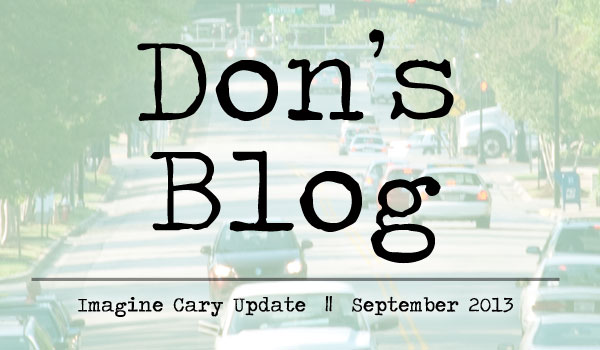Don’s Blog: Imagine Cary with Cars
Cary, NC – At our latest Imagine Cary work session, consultants presented 12 Vision and Value Statements drafted by the Committee for the Future for council review prior to being “tested” by the community via a mind-mixer website. The 12 Vision and Values statements spoke to the following topics:
- Regional Context
- Land Use
- Redevelopment and Infill
- Arts and Culture
- Economics and Fiscal Health
- Environment
- Facilities and Infrastructure
- Historic Resources
- Housing and Neighborhoods
- Parks and Recreation
- Services and Safety
- Transportation
After review of the Vision and Value Statements, the question to council was, “do you have any apprehension about testing the statements in their current form?”
With some, yes – others not so much.
One of concern was the Imagine Cary Transportation Value Statement:
“We believe in providing a wide range of functional and well-designed mobility choices – driving, walking, biking and transit – that facilitate moving into, out of, and around the community with a design emphasis on people and the human experience.”
Huh?
What the heck is “the human experience” anyways? And what does it have to do with Cary’s vision for transportation over the next 10-20 years?
It gets a little clearer when you look at the “themes” used to craft that statement.
The “themes” unanimously agreed upon by the committee include:
- Need for more bike facilities and culture
- Provide more walkability (safety/facilities)
- More regional connectivity (multi-modal)
- DECREASE reliance of cars
- Need for transit convenience
- Better localized transit
- Need for rail transit
- Need for bus transit
- Design for people, not cars
So in other words, transit, transit and more transit! The human experience must be all the new friends you meet on the bus.
Notice anything missing from the unanimously approved Transportation themes list? Oh…I don’t know, like GOOD ROADS maybe?
“Good Road Network” did make the neutral list – that means the committee was split on whether this was important or not.
I do not believe the majority of Cary citizens would agree.
But no worries – the consultants aren’t going to test the themes with the public – only the Vision and Values Statements. My concern with this is that the themes are the meat and potatoes of the statements – so why not tell folks what we really mean? Why only “test” feel-good statements than can be interpreted a number of different ways?
The council had similar concerns with a few other categories to include why such a significant focus on the arts and downtown? Heck, I’m as big a fan of downtown as anyone and even I thought it was a bit much.
The emphasis on affordable housing was also of concern. What does “…support for additional residential choices for a variety of lifestyles, ages, cultures, aesthetics and incomes organized in a walkable pattern” really mean? Is it a fancy way of saying inclusionary zoning? Is it a statement of support for subsidized housing? Let’s be clear about what we want to communicate.
And that’s what we tried to do. The council edited some of the Vision and Value Statements that we had concerns with to better reflect our community’s values and communicate our intent. These will now be “tested” on the mind-mixer website thingy ….that most average citizens won’t participate in…
To be fair and to the committee’s credit, most of the values statements required only a few word tweeks and/or the removal of a sentence here or there. There was one or two that were not edited at all.
But in the end, and regardless of the changes we made, I find myself less confident in the process than before. I have a greater concern of who is really driving the process – our citizens or special interests. Given the push-back we received from the consultant at our meeting I can’t help but wonder… Bottom line however is that if I do not have faith in the process, I cannot trust the outcome.
I appreciate much of the committee’s work and I thank them for their service. I genuinely believe they have added value to the process and we couldn’t do this without them. I just don’t believe some of their recommendations to be representative of the majority of Cary citizens, and I’d like to better understand why that is.
—————————————————————————————
From the blog of Don Frantz, Member of Cary Town Council representing District B.




I am glad to see a discussion on transit, transportation options, and planning for Cary’s future. I attended the ‘Imagine Cary’ event today at the Cary Senior Center, and I rode Cary’s Door-to-Door transit to get there–I was probably the only person there, who did not drive.
I cannot speak for all Cary Transit users, because they are as diverse in many ways as all automobile users–it is dangerous to generalize too much, as Len N. pointed out in his comments.
I am a former advocate employed by Disability Rights NC, and I have to say that we did surveys (state-wide) and asked for input every year I was a volunteer with or an employee with the state’s Rights Protection Agency (8 years). EVERY year the chief issue for those who responded was difficulty with or total lack of transportation.
The difficulty for persons with disabilities to get around contributes to folks being cut off from friends, family, community and church activities, recreation–you name it. That is why there are now kneeling buses and lifts on transit buses–Congress and President G. H. W. Bush recognized the need for communities to provide for those with disabilities, so that those with disabilities could work and play like any other citizen. The result was the ADA, which was signed into law in 1990: see http://www.ada.gov.
Most of all persons with disabilities, particularly those that can affect mobility, need help getting to the pharmacy, the doctor, and other medical related appointments. The Town of Cary and C-Tran provide excellent service in this segment of their transit services–exceeding the requirements of the American with Disabilities Act (ADA).
Just remember, Cary’s population has seen a shift towards more elderly in its population, and Baby Boomers are aging out of employment age and starting to feel the effects of arthritis, diabetes, or other diseases that affect the ability to walk and climb; they will be needing transit services, too.
My recommendation? We need to improve the transit system in Cary by reducing the wait times between buses stops (the normal time is now 1 hour between stops), and including more routes, starting with one that has bee proposed for years that will serve the Cary Parkway.
Hmmm, very little publicity on these events,
http://www.imaginecary.org/2014/07/choices-workshop-what-will-cary-be-in-2040/
Cary News article, town publicity via all sorts of channels, … what’s missing?
CaryFan2,
No one riding C-Tran I know of is looking to take your car away from you. They just want improved service so they can make a living, and take care of their families.
As for cars, the last rider survey shows 42% of C-Tran riders own one or more vehicles, but they ride C-Tran anyway. Some because of multiple people in the family working, some so they can text while riding without getting a ticket, some to avoid the stress of driving, and a host of other reasons.
Of the 58% who don’t own a car, some are seniors or disabled who can no longer drive. Many are working people who can either purchase a car, or put the money into job skill improvement training at Miller-Mott, ITT Tech, or other training institution, so they can get a better paying job, then buy a car. Some are ‘English as a second language’ students from Russia, Nigeria, and elsewhere that don’t have enough English yet to get a drivers license. There are almost as many reasons as there are C-Tran riders.
Do they want C-Tran’s hours extended? Of course, especially because of the job opportunities it opens for them.
Do they want additions routes added? Yes, particularly if they live along Cary Parkway or in western Cary.
Do they want Sunday service? Again yes. C-Tran riders would like to be able to attend church the same as people with cars.
The people aren’t “extremists”, consultants, or operating with some hidden agenda. They just ride the bus system and want the best service they can get from it.
Len Nieman
I ride C-Tran
I agree that in every way, bus services should meet public demand. I am a strong proponent of services for the disabled.
But in no way should demand be created. As I previously stated, the goal of many urban planners is to convert communities into mass transit, super dense “utopias”. With the advent of hydrogen fuels cell (& the like) within 20 years it will be a moot point anyway. I’ve done the mass transit thing & unless it’s necessary it is not a practical way to conduct life.
Look, I certainly apologize & please know I’m not saying the specific people at this meeting were extremist, I’m simply saying that the extremist have basically taken over the urban planning in most communities in general. Go online & study their philosophies…I have & frankly I was shocked.
I think Don raises an interesting point, but does a diservice to question the process. I attended several of the workshops as well as the kickoff session. What I heard from most, but not all, was that the roadway system was generally in good shape. There are some spot locations and times of day with congestion, but generally traffic moves well. The data given by the consultants backs up this view.
What’s missing is the non-car element. There’s no getting around that Cary is designed for the car, not for the person. The layout of the town requires having a car for most, if not all trips; few destinations are in walking distance. The pedestrian infrastructure is improving, but is still spotty; same for bicycles. Transit does not provide a viable alternative for most residents since few routes and limited hours of service exist.
Participants at the meetings I attended seized on this last issue. They weren’t saying cars were unimportant, but were saying that the transportation system needs to be more than JUST cars. These were ordinary citizens making these statements, not “extremists” or non-residents. People like what we have, but want more travel options.
“Cary is designed for the car, not for the person.”…Cars belong to people (who use them). Even among the segment of the population that bikes, only a very small percentage actually uses them for activities other than entertainment (sport). Check the statistics.
My only contention is that we not allow our city structure to be reengineered based on some utopian idea of how a select few think people should live. There will come a day when we simply program in our destination & our “transportation pod” will automatically take us to our destination. But until then, we need our cars & an infrastructure that can accommodate them.
I don’t think it is utopia to want to be able to get around without having to have a car for EVERY trip. We’re talking about creating options in certain areas of town; not converting the entire town to a dense development. If you want to live in a single-family neighborhood with quarter-acre lots and drive everywhere, that choice will be around in abundance. But what if you want a different lifestyle? Cary needs to offer these choices, too. Many if not most of the attendees at the meetings I went to wanted this as well.
The biggest concern for me is the exodus of our younger residents. Cary is not doing a good job keeping the millennials here. More and more studies indicate that this generation is less enamored with the car. What options are we providing them?
Think you may be missing the point, Don. Perhaps the concept of “design for people, not cars” would be clearer if stated as “…not just for cars”.
Use of the public right-of-way, especially in certain areas like the approaches to downtown, near major public facilities such as schools, and near commercial centers, should be for pedestrians and bicyclists, too…not just for car drivers.
That means including adequate sidewalks and bicycle lanes. And, on some roads, that might mean reducing four lanes (especially when they are not needed for capacity) down to three with bicycle lanes. Something that can be done with paint and no further asphalt needed at all (think N. Harrison on the approach from Maynard to Chapel Hill Road).
That’s what that goal statement means…not design for buses (although bus stop pullovers out of the lanes of traffic is not a bad use of public right-of-way, either.
How about less paint, lanes and lights and more shared space?
An Example: Poynton Regenerated – A community in decline, divided by decades of anti-social traffic engineering, is reunited and revitalised by streetscape redesign
http://www.youtube.com/watch?v=-vzDDMzq7d0
Shared spaces can work in low speed environments, although I note no bicyclists taking their chances with larger vehicles in the photo provided.
However, in a 45+ mph (should be 35mph) environment like the North Harrison approach to downtown, bicyclists need a protected area in which to ride.
This would also encourage more the more recreational rider to use that public right-of-way corridor, rather than trying to mix it up with traffic on hilly terrain, as they must do now.
I agree with your blog & I don’t think it’s a minor issue. Extremist have basically taken over the urban planning in most communities & have little respect for any view but their own. In an effort to impose their environmental beliefs (& I do mean beliefs) their goal is to convert communities into mass transit, super dense “utopia’s”. They don’t exist!
In Cary, you have an awesome, very well structured community in need of minor tweaks. One of those tweaks is definitely better roads. We should make no apologies for enjoying the independence that owing an automobile has brought. The automobile and the highway system in the United States has increased the quality of life & allowed the average person to see & go place only imagined prior to the last century.
Mr. Franz,
Over the last couple of years, I’ve become something of a C-Tran activist, and I have to agree regarding roads. How on earth are you going to have an efficient and reliable transit system if you don’t have good roads for it to operate on?
Len ‘I ride C-Tran’ Nieman